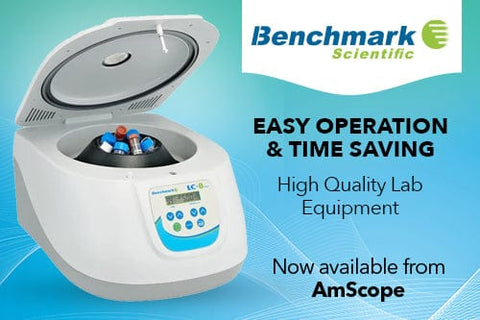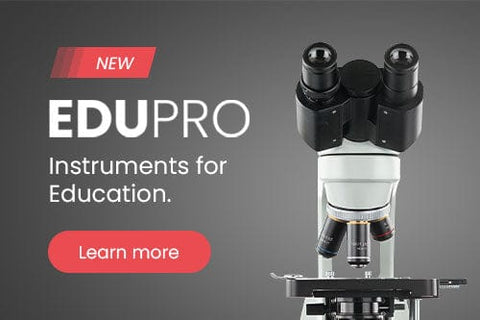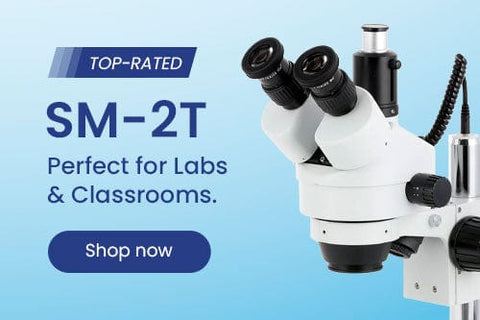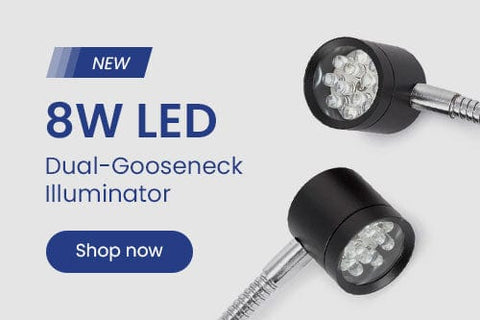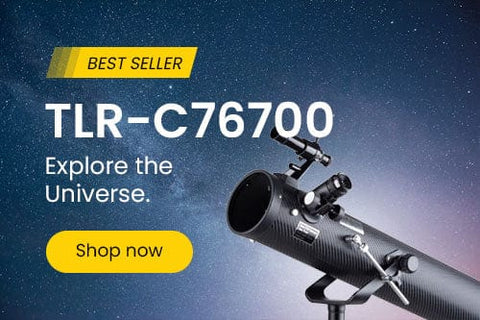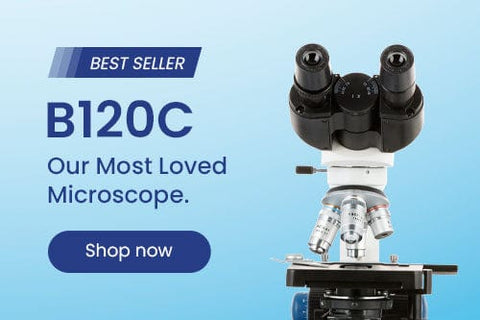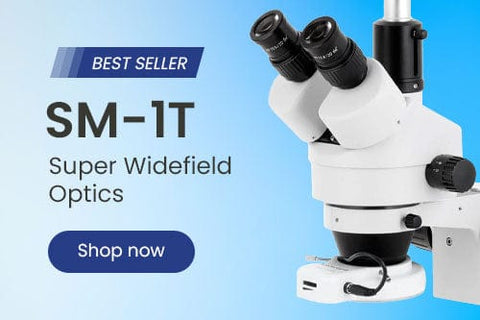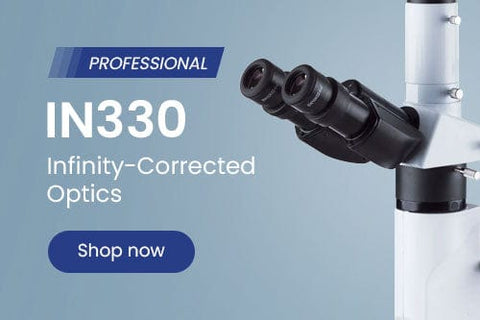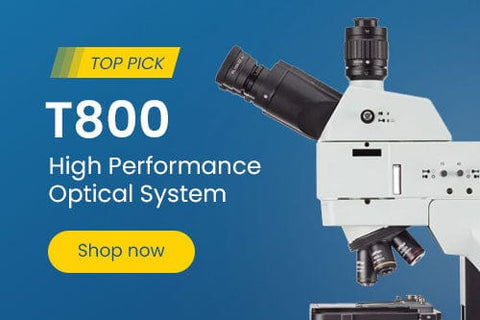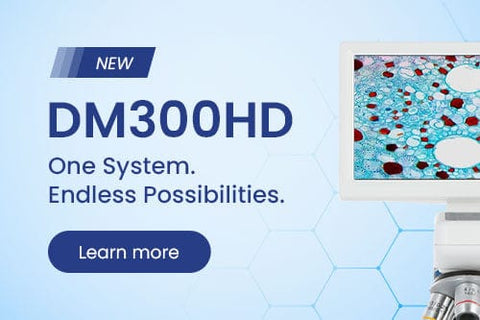Buyers Guide to Microscopes for Elementary Schools: What Microscope Should I Buy?

The microscopic world is full of unseen creatures. Protists, bacteria, parts of the plants, and viruses are just a few examples of the amazing diversity of microscopic organisms. Introducing your child to microscopics can be a great way to get them interested in biology and the world around them.
With so many different microscopes on the market, it can be tough to know where to start. In this guide, we'll break down everything you need to know about microscopes for schools, including how to choose the right one for your child and what accessories they'll need to get started. You'll also learn the following things about microscopes:
- The main functions of a microscope
- The benefits of microscopes for students
- The importance of age-appropriate microscopes
- Factors to consider when choosing microscopes for kids
- Various types of microscopes for students at different levels
- Other considerations when choosing a suitable microscope
What Are the Main Functions of a Microscope?
A microscope is an instrument used to magnify objects that are too small to see with the naked eye. Microscopes use a variety of lenses and lighting techniques to magnify objects, making them appear larger than they actually are. They have two main capabilities: magnification and resolution.
Magnification is the ability of a microscope to project an object's image on a larger scale. The eyepiece and the objective lenses magnify objects. Various lenses have different magnification to enlarge samples with precision.
Resolution is the ability to single out two light spots of a specimen. The shortest interval between two points gives a demonstration of the resolution. The resolution of an image depends on a good source of light, glass lenses, and the revolving nosepiece.
Benefits of Microscopes for Students
Microscopes are powerful tools that allow students to see things they would otherwise never be able to see with their naked eyes. They provide an up-close look at the world around them and improve students' understanding of concepts. When students see things up close with a microscope, they better understand the concepts they are learning about. This is especially beneficial for visual learners.
Microscopes lead to greater engagement in learning. Looking through a microscope is often much more interesting and engaging for students than simply listening to a lecture or reading from a textbook. This increased engagement can lead to better focus and concentration and, ultimately, improved learning.
They also strengthen the students' academic experience — especially those interested in the scientific field.
Student microscopes promote skills in observing, analyzing, and questioning different concepts when learning. Also, they encourage students to discuss and think critically about their observations — an important aspect of the scientific process that helps students develop a deeper understanding of the material they are learning.
Microscopes increase students' curiosity in finding new concepts about the specimens in their experiments because they give practical education in schools. Also, students learn to use visual information to operate the discovered unseen world— the world of microbes.
Do you want the best and recommended suggestions for school-level microscopes? AmScope.com helps you choose the right microscope for your needs.
Importance of Age-Appropriate Microscopes
Choosing the right educational microscopes for young learners can feel like a daunting task. Considering that a microscope is a piece of scientific equipment, it’s essential that it fits the grade level of the user. Beginners require less technical specs and magnification power, for example, whereas students in more advanced classes need microscopes with greater capabilities.
What Are Some of the Factors To Consider When Choosing Microscopes for Schools?
There are many factors involved in selecting the right microscope for schools — simplicity and durability are chief among them. Here are some factors to consider when selecting the best microscope:
1. Types of Microscopes
There are two primary types of microscopes: stereo microscopes and compound microscopes. Stereo microscopes are more suitable for kids in elementary schools and middle schools, whereas high schoolers and undergraduates mostly use compound microscopes.
Stereo microscopes are lower-power equipment used to view 3D specimens. They are available with three types of magnifications:
- Fixed power
- Zoom power
- Single lens
In contrast, compound microscopes are considered “high-power” and are perfect for viewing specimens with naked eyes. Its high magnification power creates a larger image of the object. This function contrasts the stereomicroscope. Its magnification range is 10X–400X.
2. Monocular and Binocular Microscope Heads
The head is the upper part of a microscope that houses objective lenses and the eyepiece. There are two main types of microscope heads:
- Monocular
- Binocular
For general use, monocular microscopes are ideal. Most people look through a monocular microscope with one eye closed. This technique often results in the user suffering from eye strain and fatigue. It is recommended to practice looking through a monocular microscope with open eyes to reduce eye strain and fatigue.
Compared to monocular microscopes, binocular microscopes are more comfortable during long observation periods. Nevertheless, they are not the best selection for young children. Fully-developed brains merge the pictures seen by each individual eye to construct one picture, but younger children struggle with this.
Monocular microscopes are recommended to be used in classrooms and laboratories. The specimens appear flat, making it easy for students to identify what they've learned in class. Binocular microscopes are utilized in industries to execute in-depth analysis. They are also recommended in laboratories to perform research where scientists take part in long observation periods.
3. Course Level
Grade school microscopes have different capabilities from those designed for use in advanced university courses. For example, compound microscopes are often used to study viruses and bacteria. As a result, these microscopes are not needed by toddlers or preschoolers but by high school students and university scholars.
Simple microscopes are recommended for children because they can view a magnified image of three-dimensional specimens. They do not need complex details to view and record samples.
4. Robustness and Durability
Microscopes for schools must be designed for durability. They should be well balanced with their bases firmly planted on the workspace. They should also have very few removable parts to ensure that pieces don’t get lost or stolen.
That being said, if a part is destroyed or misplaced, having removable parts in a microscope is a useful feature. Replaceable features of microscopes include eyepieces, light bulbs, and objective lenses. These are required to maintain the working condition of microscopes.
5. Light Source
There are four primary sources of light: LED, halogen, tungsten, and fluorescent.
LED lights are an increasingly common choice for microscope light sources. LED lights used with rechargeable batteries make microscopes fully portable, which allows students to use microscopes in the field.
On the other hand, halogen bulbs produce a strong, white light. You can adjust the strength of the white light with a changeable rheostat.
Tungsten is the basic illumination for entry-level microscopes. Fluorescent light is typically used for biological research in universities. They are also used as additional light sources in stereo microscopes when more light is required.
6. Accessories
Different microscopes come with various accessories, including:
- Replacement bulbs
- Slides
- Instruction books and activity books
- Microscope cameras and adjustable ring lights
- Polarization kits
- Microscope stands
- Eyepieces
Other microscope accessories include prepared slides and experiment cards that contain fun experiments to stimulate students’ curiosity and inspire independent research skills.
Best Microscopes for Students in Elementary School
Young children are naturally curious. Microscopes for schools can be amazing tools that stimulate the love for science in children. When buying the best microscope, consider durable and easy-to-use ones. Keep in mind that you do not need an extremely high-power magnification microscope for elementary school children.
Consider the IQCrew Kids Pocket Handheld Microscope. This model is for kids who have just begun to use the microscope in their studies. It features 20X-40X magnification, and its convenient, pocket-sized layout makes it easy to take outside. This microscope comes with an illustrated book that introduces enthralling experiments to help children understand what they observe. The hand-held microscope is perfect for examining stamps, bugs, plants, and more.
The IQCrew 20X LED Stereo Microscope Portable is suitable for slightly older elementary students. This microscope for elementary school has in-built battery-powered LED lighting. It features 20X stereo magnification power, which gives children the ability to examine all kinds of objects closely. A cordless version is also available.
Best Microscopes for Students in Middle School
Young scientists will love our IQCrew Science Discovery Series Inverted USB Digital Microscope set. It has a strong magnification of 40X–500X and is characterized by a unique inverted design. The complete kit includes two eyepieces, a Petri dish, blank slides, a graduated cylinder, pipette, forceps, a probe, a stirring rod, and an illustrated book.
Another option for middle school students is the IQCrew by AmScope 40X–1,000X Digital Microscope with Dual Illumination. This model offers a great way to introduce kids to the basics of using a compound microscope. It holds a magnification of 40X–1,000X and comes with a pack of prepared slides. This grade school microscope has a dual-LED illumination designed for examining translucent and opaque specimens.
For a complete list of microscopes for students in grades K–8, click here.
Best Microscopes For Students in High School
In high school, students normally start using laboratory-grade compound microscopes. We offer a broad assortment of microscopes to support high school science courses.
For example, the 40X–2,500X Biological Binocular Microscope Kit is a convenient package for schools. It gives the sophistication of a college-level microscope and provides magnification settings from 40X to 2,500X. It uses a halogen light source and has separate coarse- and fine focusing capabilities. This kit comes with five pre-mounted specimen slides and everything students need to create their own slides.
The 2,000X LED Lab Trinocular Compound Microscope with USB2 Camera + 3D Mechanical Stage is another great choice for high school classrooms. The model combines a USB2-powered digital camera with powerful photography and editing software. It gives students the amazing opportunity to create and present slides in class and is an ideal tool for independent research projects.
Best Microscopes for Students in College and Graduate Programs
Besides magnification power, students in higher education should look out for a microscope’s durability and simplicity. A binocular viewing head with LED lights is a bonus point. We offer a range of microscopes ideal for college students in the science field.
The 40X–1,000X Biological Binocular Compound Microscope is ideal for college students. It comes with a complete set of advanced features like a 45-degree inclined 360-degree swiveling sliding binocular head, four DIN achromatic objectives, and a digital camera that captures images and videos which can be live-streamed on a PC.
Research microscopes offer professional, scientific tools to graduate students. For advanced studies and highly technical research projects, it’s crucial for university students to select the right microscopes for school.
Digital microscopes that come with a camera or tablet LCD camera are also available — and highly popular. The AmScope B490B-3M, for example, is a versatile microscope that comes with a digital microscope, a full-size professional microscope equipped with a 3MP digital camera, and a host of accessories and attachments. This microscope is perfect for students, doctors, vets, and clinics.
Shop the full guide of premium microscope all-in-one bundles for schools.
Other Considerations
Materials and Quality Optics
Microscope frames come in both metal and plastic materials, but keep in mind that metal-based materials are more durable. This is especially important for high-traffic sites like school labs. Look for well-built, solid microscopes that come with quality optics.
These lenses help students visualize all minor details in the slides when observing them. Cheap microscopes have plastic objective lenses and eyepieces. Plastic optics often create images that are difficult to focus on, which causes eye strain and poor visuals. As a result, microscopes with glass optics are much preferred.
Another crucial thing to consider is whether the objective lenses are achromatic. Monochromatic lenses are color-corrected. They are superior to simple lenses when it comes to white light imaging. We offer both achromatic and monochromatic lenses as accessories in most of our models.
Source of Electricity
All microscopes need a light source for detailed viewing. There are cordless microscopes and ones with cords. Students could trip over cords when working around the room. Thus, microscopes for schools typically rely on batteries. The 40X–800X Dual Light Student Compound Microscope includes two AA batteries and an AC power adapter.
Visual Field and Resolution
Look for microscopes with wide-field eyepieces — especially for high school students and university scholars. Wide-field eyepieces provide an easy way to position the eyes to see into the eyepiece, but it is important to ensure that the microscope comes with objectives that provide good resolution.
Magnification
Magnification between 5X and 400X is recommended for kids under ten years old. Most ocular lenses have a 10X magnification. A common group of objective lenses on a microscope consists of 4X, 10X, and 40X lenses.
We recommend investing in a school-level microscope with at least 400X magnification. The 400X magnification is suitable for students ranging from elementary age to high school.
Final Thoughts About Microscopes for Schools
The microscopic world is fascinating to explore, and there is much to learn about science and the environment around us. Looking under a microscope is an enriching and educational experience for students. If your child is raised in a science-friendly environment, they can think critically, ask questions, and seek their own answers — all of which help them develop critical problem-solving skills in life.
Find microscopes for schools and set your students up for intellectual and academic success.




